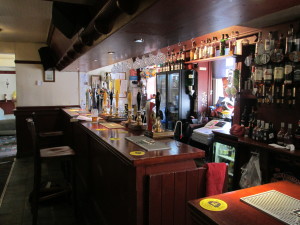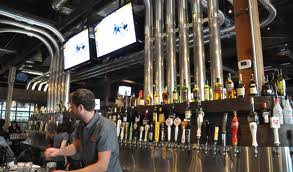 In my latest Beer 101 column (I don’t say new because, to my embarrassment, it has been up for almost a month) I re-visit, from a slightly different angle, a topic about which I often muse. I examine the dynamic where beer aficionados prefer bigger, bolder, brasher beer over an equally-well made but more subtle and quiet beer. You can read the whole column here.
In my latest Beer 101 column (I don’t say new because, to my embarrassment, it has been up for almost a month) I re-visit, from a slightly different angle, a topic about which I often muse. I examine the dynamic where beer aficionados prefer bigger, bolder, brasher beer over an equally-well made but more subtle and quiet beer. You can read the whole column here.
I am not really talking about styles here, at least not this time. I mean this in a more general sense. Sure, beer geeks will opt for a double IPA over a cream ale most of the time. And fair enough. But they also drift toward more assertive, more aggressive or more novel interpretations of a style. Also fair enough. But that doesn’t mean that I really understand the process involved in that kind of selectivity. Plus I have long felt it sells wonderfully crafted beer short simply because they are aiming to be something quieter.
My summer travels across the pond have got me thinking about this question in a different way. I offer a fuller re-count of my beer palate reactions during and after my trip in the column so will only briefly summarize it here. In short, I was at first disappointed by British IPAs because they lacked the zesty, strong hop presence we expect in North America. But after some acclimatization I started to really enjoy the balance and quaffability of their interpretations. However, that is not the end of the story. As I neared the end of my trip, I found my enthusiasm for cask ales waning somewhat – too much of a good thing. Basically, I was longing for the familiarity of my own bed. In beer terms, that meant the crisper, more angular flavours that come from North American beer. More hops, fewer fruity esters, etc.
Of course, as a surprise to both myself (and readers), my choice of a first beer back was Mill Street Don Valley Bench, their summery chardonnay-esque wheat beer, in their Toronto Airport pub. I could have chosen a Tankhouse Ale or their IPA for a bigger hop hit, but my palate called for something cleaner and more refreshing. Maybe it was allowing for transition. Or maybe I just was open, once again, to a quieter, more subtle beer.
I think my point in these ramblings is to suggest that we, quite naturally, grow accustomed to certain flavours and profiles. For the beer geek, we want to try the latest new offering from Dieu Du Ciel, Brew Dog, de Molen, Mikkeller, Green Flash, etc. (insert your favourite “out-there” brewery here) and have – possibly without knowing it – edged our expectations and our palate to the farther edges of the scale. So much so that when someone offers us something more in the middle of the flavour spectrum, we find it boring, lacking complexity and missing an outstanding feature.
I often point to the beer rating sites as an example of this phenomenon. I do not criticize those sites; in fact I find them useful gauges from time to time, and often utilize them when going to a city or region for the first time. But I can’t help but notice a built-in bias toward big, alcoholic, hoppy, aggressive beer, both within styles and between styles. Don’t believe me? Check the range of top scores for Russian Imperial Stout and compare it to the top scores for Oktoberfest. On ratebeer.com the top 100 RIS’s score above 99.79, while the top-rated Oktoberfest is 95.9 and only 9 score higher than 90.
This is just one example, used for illustrative purposes. Other websites will show the same pattern, as will other style comparisons.
However, it is telling. It is not that the top 200 or so Imperial Stouts are all better than the world’s 10 best Oktoberfests. Impossible. It is just that the members of the site find more to chew on with RIS than they do Oktoberfest. These leads to an unconscious process of slightly downgrading the score of the more subtle beer.
Of course, you can easily argue that comparing across styles is a fool’s game. Maybe. But I think that a good palate and an open mind can honestly evaluate two different styles and give them scores that match their comparative quality (approximately).
In the past I have talked about the importance of respecting each style for what it is and judging each beer based upon what it is trying to be. However, my recent trip has me thinking that there is more to it than that. In addition to be aware of style intentions, we also need to keep our expectations and palates sharp. And we can only do that by regularly consuming beer of a whole assortment of flavours, profiles and sizes. That is kind of what happened to me in Britain. I wasn’t prepared for real British IPAs and it threw me.
It can happen to all of us. Since returning, I have been trying to mix and match my beer more often. I have never really drank the same beer twice in a row, but now I am more consciously trying to make broader and deeper variations in what I sample. I mix up my styles (always have) but these days I am also intentionally picking up beer that are less aggressive alongside those that are more aggressive, to ensure my palate (and my expectations) can never rest on their laurels.
I think, and hope, that it is making me a better beer consumer and a fairer, more fine-tuned judge of ALL kinds of beer.




December 3, 2013 at 9:09 PM
As someone that has tried thousands of different beers, I find that the bigger and bolder styles tend to stand out more and be more memorable. It’s not that I don’t appreciate a well done subtle style, but it tends not to be as memorable for me. That said, “standing out” can go in either direction, good or bad, so using your example, I wonder how the worst RIS’s compare to the worst Oktoberfests?
December 5, 2013 at 11:13 AM
You make a good point, Ernie. I completely understand that. As for your question about the worst Oktoberfests, unfortunately I can’t test that (or at least haven’t figured out how), but my guess is that the lowest rated Oktoberfest will score worse than the lowest rated RIS. I think the elevation effect still stands in those cases.
December 6, 2013 at 3:57 PM
Fair enough. In the more subtle styles, flaws stand out more, too. It’s easier to cover up minor brewing issues with a crap-load of hops in a double IPA than it is in a light malty style.
December 4, 2013 at 10:51 AM
Being born and raised in England, I certainly know that beautiful range of cask ales that are available. The amount of flavor that can be packed into around 3-4.5% ABV ales is astounding.
However, since moving to Canada I have also learned to appreciate big, high ABV monsters. Its all about time and place. I used to love sitting in my local quaffing multiple pints of Harvey’s Sussex Best among the myriad of other brews. On a cold winter night in northern Canada though, an Imperial Stout really does the trick.
December 5, 2013 at 9:23 AM
Well said! I think when a person picks up a particular style they have to fully understand and appreciate what the beer is trying to accomplish before they even drink it. You will then never be disappointed (unless the beer fails miserably to hit its style). Having respect for all styles is the key. Just because a kolsch is not as hopped up, or as bold as an IPA does not make it any less spectacular. After all a true kolsch is a thing of beauty. If a person does not realize this and feels one style superior to another is truly missing the joy in craft beer. How, can that individual truly call themselves a craft beer drinker, or lover of craft beer, when they fail to appreciate the beer for what it truly is, and for what the brewer was truly intending. This goes beyond each individual’s personal tastes, as after all not everyone likes brussel sprouts and broccoli, so how can everyone like every style.
December 7, 2013 at 5:57 PM
There is a time and a place for every beer.
December 7, 2013 at 6:04 PM
Succinct and wise. Couldn’t have said it better – of course that would have been a VERY short post…